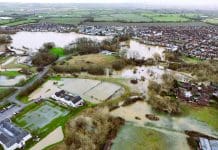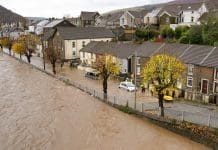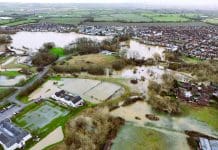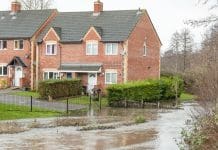Mary Dhonau OBE, chair of the Property Care Association’s Flood Resilience Group, sets out some of the actions that can be taken to reduce the impact of flooding – and why a co-ordinated approach is vital
As winter approaches, the impact of any prolonged wet weather or flash flooding could see homes across the UK affected. I know from personal experience the heartache and devastation felt when a home is flooded.
Being flooded is just awful but often, far worse is the recovery. Some people are not yet back in their homes from Storm Desmond, which struck large swaths of Northern England in December 2015. Poorly executed works also prolong the anguish and come as a double blow when people are already at a low point.
So, back in 2014, I was delighted to take up the position of chair of the PCA’s Flood Resilience Group. The group was formed after we saw first-hand the impact of poor quality, unregulated works to recover homes in Hull and many other areas affected by the catastrophic floods of 2007.
In many areas, householders not only had to suffer the impact of flooding but also the effects of poor quality recovery work, which meant they were unable to get their lives back to normal for years after the event.
Recognising the positive impact PCA members – whose expertise centres around managing water and damp in buildings – could provide in this area, the PCA Flood Resilience Group was formed with specific training, the development of a Code of Practice and other initiatives designed to give insurers and householders a route to trusted specialists. Three years on and today the group’s expertise extends across the key areas of flood resilience, resistance and flood recovery.
Flooding can be managed but not stopped altogether. Homeowners must be aware that while flood alleviation schemes reduce the risk of being flooded, they do not take it away. We witnessed that during the winter floods of 2015, when flood defences in Keswick and Carlisle were overtopped and the Foss Barrier in York was overwhelmed.
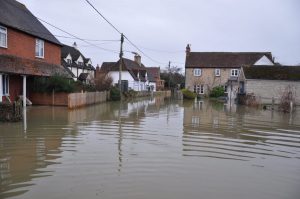 However, the good news is that the expertise developed in this time means the group is well-placed to offer a range of solutions to significantly reduce residual risk at an individual property level.
However, the good news is that the expertise developed in this time means the group is well-placed to offer a range of solutions to significantly reduce residual risk at an individual property level.
Flood resilience
Modern innovations and professional techniques mean homes can now be made more resilient to enable them to withstand the effects of flooding more effectively.
Property flood resilience measures can help reduce the impact of future floods by keeping water out as far as possible or, where flood water cannot be prevented from entering a property, minimising the damage and ensuring the water is removed as quickly as possible.
Resilience measures are designed to speed up the time between when a building is flooded and when the occupant can return.
Resilience measures include:
- Replacing standard gypsum plaster with one of the alternative types that do not absorb water (such as a cement render) and using ceramic or stone tiles with waterproof adhesive and grout.
- Fitting plasterboard horizontally, so it can be removed and replaced quickly.
- Using closed cell insulation.
- Moving all services, such as boilers and electric sockets, high up on the wall. Kitchens that can be cleaned, dried and reused using materials such as marine ply or steel can also speed up recovery works.
- The fitting of a membrane to walls and floors so any water can run behind it to be collected in a sump/pump unit, rather than entering the property, is another effective measure.
Keeping water out as much as possible in the first place through flood resistance measures can be achieved in a number of ways.
Resistance measures include:
- The fitting of flood barriers to doors or replacing doors completely with a flood-resistant alternative.
- Replacing standard airbricks with ‘self-closing’ alternatives.
- Fitting a ‘non-return valve’ to prevent sewage going back into the building.
- The fitting of a pump to evacuate water coming from beneath the building.
Flood recovery
Having a property affected by flooding is a devastating experience. It’s bad enough losing all your belongings to floodwater but watching your own home being turned into a building site and often having to act as project manager for your own repairs is soul-destroying.
As I have mentioned above, all too often, properties can be recovered by contractors with little understanding of the impact of water on a building and a future legacy of further problems down the line.
Members of the PCA Flood Resilience Group are well-placed to ensure buildings are restored to their correct condition effectively and efficiently.
They also advocate the use of flood property resilience measures to reduce the impact on the home from any future flooding.
Members of the group can offer the following services:
- Assisting in the recovery of a building
This is achieved by monitoring and inspecting the drying structure. Members of the PCA Flood Remediation Group can assist the company undertaking the drying aspects and can conduct investigations to highlight areas at greatest risk from fungal decay or degradation. This service can considerably speed up the drying process and will reduce the possibility of problems of dry rot and other latent defects affecting the building after the refit is complete.
- Providing effective repair and reinstatement solutions to buildings affected by floodwater
In simple terms, the effect of flooding is to put unwanted water into the fabric of a building. Members of the PCA deal with these problems daily and their experience in dealing with rising and penetrating dampness can be applied to a flooded building.
A member of the PCA Flood Remediation Group can provide reinstatement solutions able to cope with the damage caused by water ingress. Utilising this expertise will greatly reduce the possibility of future problems. In our experience, problems with repairs relating to flooding are common – but may only surface months or years after the property is repaired. It may also be possible to use products and techniques that will allow a building to be repaired and reoccupied before the fabric of the building is completely dry without compromising the repair or living conditions.
- Providing refurbishment and repair solutions that offer greater long-term resilience to future floodwater ingress
In some circumstances, it may be possible for members of the PCA Flood Remediation Group to undertake repairs that will provide the building with far greater resilience to future floods. The use of innovative materials and techniques previously seen only in underground waterproofing may be adapted to above ground situations to provide a degree of water management capable of reducing the impact of future flooding events.
The next steps
Flood resilience offers a common sense approach but for action to occur, we need clear leadership from the government to drive forward the issue. Action can include allocating the use of any flood damage grants issued by the government to build-in future flood resilience rather than just a repair and replace process. Insurance repairs can also take the same approach.
Then, at least, we as a nation can start to feel less vulnerable to flood events in the future.
An example of how flood resilience measures can be introduced to properties can be viewed in a PCA video at https://www.youtube.com/watch?v=qjU902ZbEM0
Mary Dhonau OBE
Chair
Property Care Association Flood Resilience Group
www.property-care.org/homeowners/flood-protection/
Twitter: @PCAPropertyCare


